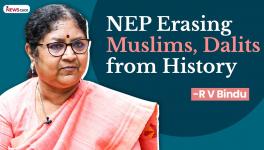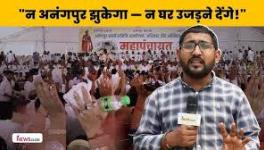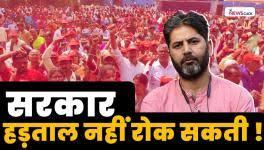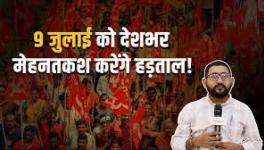UGC Framework --A Communalised Caricature of Indian History: Irfan Habib
This is the revised version of an article written by eminent Marxian historian Prof Irfan Habib in March this year. It was originally published in Social Scientist magazine, and has been made available to NewsClick by SAHMAT or the Safdar Hashmi Memorial Trust.
We are revisiting the article in the backdrop of the controversy over the University Grants Commission’s draft history syllabus, which has dropped books by well-known historians, such as DD Kosambi, R S Sharma, DN Jha and Irfan Habib. Instead, the draft syllabus proposes to embark on a saffronisation agenda by including books by some authors who are said to have allegiance with the Sangh Parivar. For instance, the objective (ancient India) seems to be to glorify mythology rather than history, as also deny any Dravidian links to Harappan culture, says Prof Habib in this article.
We have to remember all the time that we have a regime whose leading light, soon after occupying the office of Prime Minister of the country in 2014, announced that India had known plastic surgery as early as the mythical times when our surgeons fitted an elephant head on the body of Lord Ganesha. It was to be expected that History would soon receive enlightenment of this order through a reshaping of History syllabi at University levels.
A first step to this effect has now been taken by a dutiful University Grants Commission, via a so-called “Learning Outcomes based Curriculum Framework (LOCF): BA History Undergraduate Programme, 2021”–the high-sounding title prefacing a mere set of syllabi. This means that universities are now expected to adopt the “framework” and arrange their teaching and examinations according to the topics specified in this text, while the books listed in the bibliographies are to serve as sources for these topics.
It is to be assumed that themes not included in this ‘framework’ cannot have questions asked on them in the BA degree examinations. These would thus be necessarily excluded from teaching. On the other side, topics here emphasised would naturally receive a larger share of attention in examinations and would, therefore, claim more time in the class rooms and in the students’ personal study.
Such being the case, one would have thought that the “framework” now offered by the UGC should be the handiwork of veteran teachers and scholars. But surprisingly enough, no names of the authors of the Framework are furnished. In other words, there is no assurance that historians of repute and experience have at all been involved in this very serious—and for History teaching, crucially significant—exercise.
In our note the review of the “Framework” is confined to the syllabi it sets for the papers on Indian history, where naturally enough, the ideological offensive of the present regime is mainly to be expected.
The very first indication of what is now afoot comes from the way papers on Indian history are here organised. Our country’s history is covered in six papers, in which the medieval (1200–1707) is assigned just one paper, so that it will be assigned only one-sixth of the students’ time, relative to about one-third or one-fourth that it receives in most university history syllabi today.
The Preamble
We are first offered a Preamble, in which high-sounding words sit uncomfortably with frequent grammatical and spelling lapses. We are told of the need to promote among students “a feeling of ownership of their own history”—an absurd formula if it means that you can shape history as you like since you own it.
We are told in the very first sentence that by History we obtain “knowledge about a nation’s soul”. This surely means that History as taught must glorify—whatever be the true facts—whatever has happened (or not happened) in the past. There is unfortunately no stress in the whole “Preamble” about the necessity of absolute accuracy as well as of comprehensive factual coverage in History that is to be taught, except a very casual expectation that a historian needs to be “objective” in his treatment of evidence.
Ancient India
When we come to the syllabus set for ancient India (Paper III: ‘From earliest times to 550 CE’), we soon realise that mythology, not history, is its framers’ chief objective. The civilisation unearthed at Harappa and Mohenjo Daro – known to the world as “Indus Civilisation”, and to official Indian Archaeology (so far) as “Harappan culture”– becomes “Indus-Sarasvati Civilisation” in the syllabus.
Sarasvati, a minor seasonal stream from the Shivaliks, has its name linked here to the Indus only to establish that the Harappan culture was Vedic by the new nomenclature since Sarasvati is mentioned in the Rigveda. The anxiety here is also to deny any Dravidian links to Harappan culture, though the case for such links is very strong owing to the frequency of the fish sign and the position given to the arrow sign in the inscriptions on the Indus seals.
Indeed, the sentiment for our ‘Aryan’ origins is so strong that the syllabus sets a special topic “Original home of Aryans”. That a syllabus for Ancient India should be so concerned with this topic suggests that its authors espouse a Nazi-like love of the Aryan race. The partisanship of the syllabus-framers is made further clear by the next topic: “the myth of Aryan invasion”. If it is a “myth” why bother with it! The very title given here to the culture of the Vedic times is “Aryan Civilisation”, as if belonging to the “Aryan” race sheds some particular honour on Indians. All this in today’s world, where any sign of racism is scrupulously avoided, seems a product of deranged minds, not historians.
Under the same designation, we have the odd topic “Epic literature and Culture”, as if there was a period when the events narrated in the Ramayana and Mahabhārata, really took place, so that the syllabus can set students the task of establishing their “historicity”. The syllabus framers apparently visualise the “epic” period as a real historical stage occurring between the ‘Vedic age’ and the age of Gautama Buddha.
Turning to the next Unit (6th century BC to Mauryan times), the syllabus takes mahajanapada to mean ‘republic’ for which there seems no sanction in our sources.
Here an important lacuna in the syllabus presents itself. By the Buddha’s time, the caste system, with its varṇa and jāti constituents had firmly established themselves and the sudra and outcaste jatis had emerged, along with slavery. It is astonishing that the syllabus should have no space for the emergence and evolution of the caste system. In fact, the only reference to ‘caste’ occurs in the syllabus for Medieval India (1200–1707), as if it was only a medieval phenomenon!
It is to be a source of wonder how we can be expected to understand our past if we overlook the oppression of the out-castes and the sūdras. Characteristically, R.S. Sharma’s important work, Śūdras in Ancient India, is not included in the bibliography of the paper on Ancient India.
I here pass by the slip that Alexander’s invasion (‘Greek Invasion’) is put after the Mauryan period and the word ‘Indica’ is just recorded, without indicating that Megasthenes’ (lost) Indica is meant.
In respect of post-Mauryan polities, first, the syllabus gives us a special theme, ‘Reorganisation of republics’—which is a purely imaginary theme based on the mere existence of some tribes or principalities known to us only by name and nothing more. On the other side, the Kushan empire on which our knowledge is considerable through inscriptions, coinage and Buddhist tradition, with Kanishka as its central figure, is merely listed as one among various dynasties.
No one would realise from this syllabus that (a) Prakrit was the principal written language of the period 300 BC–250 AD, and (b) simultaneously this was also a rich phase of Sanskrit literature: post-Mauryan Patanjali, the grammarian, belonged to it, and also did texts like Manusmriti, the Mahabharata and the Ramayana, and the Kamasutra. The Buddhist text, the Milindapanho, belonged to this period, during which the Mahayana school of Buddhism also arose, making its way to China. All this is ignored in the syllabus.
Indian History: Communal Division
No reason is advanced, why the paper on Ancient India (Paper III) is made to cover such a long period while the next paper on Indian History (Paper V) covers only 650 years, though one can hardly argue that information about it is richer than about the preceding period, the inscriptions remaining our main source of political history, here too, but for Bāna for Harsha and the Rājatārangini for Kashmir.
It is remarkable that two sources about one figure about which we know so much viz. Harsha (not ‘Harsh’ as in syllabus), viz. Yuan Chwang (Xuan Zhuang) and Bāṇa are ignored. Such is also the fate of Alberuni, who in 1035 in his Kitābu’l Hind gave us a remarkable description of Indian culture, religious beliefs and sciences entirely based on Sanskrit sources. There is on the other side, exceptional concern for Rajputs (Rajaputras), for both their origin and supposed ‘fall’.
As one would expect, eyes are kept closed toward the Arab regime in Sind (established, early 8th century) and its role in the transmission of Indian religious notions, astronomy and mathematics (especially Brahmagupta’s writings) and Indian numerals to the Islamic world (whence the numerals made their way to Europe).
A major theme of discussion among historians since D.D. Kosambi’s writings and R.S. Sharma’s Indian Feudalism, has consisted of the nature of agrarian conditions during this period, along with the curious disappearance of gold and silver coinage. The syllabus framers appear to be totally unaware of this debate and the rich amount of information it has yielded on the economic and social life of the period.
On the other side, a theme has been included, a topic, which simply does not belong to this period, viz. “Muslim rule in Delhi” and “Impact of Muslim rule on India”. What the syllabus-framers intend to cover, without offering any particulars themselves, is left unstated. One can only infer that the intention is to invite denunciatory comments on “Muslim rule”.
Under Unit V, it is curious that the topic of arrival of Islam as a religion, along with Sufism, (a major text of which, viz. Kashfu’l Mahjub by ‘Ali Hujwiri, was composed at Lahore before 1071 AD) finds no mention in the syllabus.
Paper VII, ‘History of India, 1206–1707’) has supposedly received special attention from the authors of the UGC’s Framework’ for they claim that they have carried out a “serious modeling (sic) of medieval period … for a better understanding of Nation (sic) history”.
Indeed the ‘remodelling’ is mind-boggling. The entire Delhi Sultanate is covered in just one sub-unit out of four in Unit I. Gone is the troublesome task of explaining Alauddin Khalji’s agrarian and price-control measures or Muhammad Tughluq’s effort at agricultural recovery. ‘Early Turks, Khaljis, and Tughlaqs [and] Invasion of Timur’ are all put in just in one unit.
The omissions are also all-sweeping in Unit II. Apart from the oddity of placing ‘Surs’ before Babur’s “invasion”, the student is freed from all concern about Akbar, whether his conciliation of Rajputs, his land revenue measures, his policy of religious tolerance and principle of sulh-i kul (total peace), translation of Sanskrit works, and the premier premodern statistical, cultural and administrative survey of the country (the A’in-i Akbari) of his minister, Abu’l Fazl. Even the name of Akbar is not mentioned. On the other side, the main characters on whom the candidate is to concentrate are all duly recorded: “Hemu Vikramaditya, Rana Pratap, Rani Durgavati and Chand Bibi”!
Similarly, Jahangir and Shah Jahan are ruled out of history-- of Mughal emperors-- besides Babur, Aurangzeb alone is mentioned, but what is stressed are rebellions or acts of resistance against the Mughals. Ignorance is here bliss: Hindu pad-padshahi, a phrase attributed to Peshwa Baji Rao during the reign of Muhammad Shah, is now assigned instead to the reign of Aurangzeb, and made an important topic to be studied by the student in a paper to which it does not belong.
The communal division is carried into social history under Unit IV, where “Hindu society” is to be studied separately from “Muslim society”. It is as if the “two-nation” theory is to be extended backwards to the Mughal age as well.
Paper IX deals with History of India, 1707-1857, which means that the rise of British power, traditionally dating from Plassey (1757) is not regarded as the major period-setting event, yielding in importance to the death of Aurangzeb (1707). Chronology is further sacrificed when Punjab under Ranjit Singh is put before events in 18th century in Unit II. Here also by clubbing Mysore with Hyderabad (sub-unit 3), it is ensured that Mysore’s heroic role in resisting British expansion can be overlooked while setting questions.
The period of this paper saw the beginning of social reform movement with which the name of Ram Mohan Roy is so deeply connected. The paper excludes this altogether. Sati and slavery might not have been abolished at all, to go by this syllabus. On the other side, it speaks of ‘Cultural Resistance’ without specifying any particular person or movement.
The syllabus framers apparently have never heard of the whole issue of Tribute and, further, of the Imperialism of Free Trade, the twin processes by which India was economically exploited and further impoverished. It is also curious that the East India Company’s agrarian measures, notably the Permanent Settlement, the Ryotwari and Mahalwari systems, all heavily burdening the peasants, are simply tucked away after ‘banking’ under the rubric of “Land revenue” (Unit IV. 2).
National Movement
When we pass on to the next paper on Indian history, viz. Paper X, we find it to be titled “Indian National Movement (1857–1947)”. This means that the economic, social and cultural history of India as well as British administrative and ‘constitutional arrangements’ of the period are totally missed. Even the Bengal famine of 1943-44 escapes notice. This is a severe shortcoming and the paper needs to be properly retitled and all the major elements making up the history of the last 90 years of British rule should be presented so as to make even the National movement better appreciated, given its objectives and successive stages of growth.
Except for such slips as pairing the Khilafat issue with Rowlatt satyagraha (Unit II, iv) rather than Non-cooperation (Unit III, i), or the placing of Quit-India movement with the Tripura crisis (Unit III, iv) rather than Unit V, preceding sub unit i, the various aspects and stages of the National Movement seem to be properly covered.
Modern India
Finally, we have Paper XI setting forth the post-1947 history of India, designated ‘Modern India’ (instead of ‘Contemporary India’), closing with 2000. Certain curious omissions deserve to be noted. There is, first of all, total omission of the communal slaughter of 1947-48 and Gandhiji’s valiant fight against it, ending in his martyrdom. It is terrifying to feel that such a terrible event, perhaps the greatest spate of ethnic cleansing and large-scale massacre in the world since World War II, can simply be erased from ‘national’ memory, as the syllabus for this paper suggests.
If B.R. Ambedkar is singled out for the drafting of the Constitution (Unit I, i), one wonders how Jawaharlal Nehru can be left out for presenting the vision of a secular ‘Socialist’ India, with a mixed but planned economy and full-scale land reform. His propagation of a scientific temper too remains unmentioned.
While Unit II (iv) is devoted to ‘parliamentary democracy’, the syllabus should have found some space for the Emergency and its curtailment of elementary freedoms during 1975-77.
Simple mention of ‘social justice’, under Unit III, iv, is not enough. One should have specific mentions of laws in favour of women’s rights, such as Special Marriage Act, 1954, the Hindu Code, 1955, and subsequent anti-dowry legislation. Similarly, there should be more specific mention of affirmative action in case of Scheduled Castes and backward classes. Merely speaking about “identity politics” (a favourite BJP phrase) in Unit IV, iv, while avoiding the word “secularism” is not sufficient.
Cultural Heritage
The Indian History papers discussed above are followed by Paper XII, titled ‘Cultural Heritage of India’. This paper is so conceived that two of its four units are concerned with what in essence are religious rituals, fairs, festivals and legends. These may be good stuff for visiting tourists from abroad, but hardly constitute part of India’s rich cultural heritage.
What the course under cultural Heritage should consist of should mainly be India’s contributions to humanistic thought and to reason and science down the ages, besides its contributions to learning and fine arts. For example, one could select literary contributions, e.g. from the Rigveda’s Creation Hymn, passages from the Upanishads, the Dhammapada, Aśokan edicts, Kalidasa, Amir Khusrau, and Tagore, among others. Similarly, the heritage of reformers from Ram Mohan Roy to Mahatma Gandhi should be emphasised. This should replace Units I-III. In Units III and IV, there is need to add sculpture and painting besides a more academically oriented description of styles of architecture (with attention paid to techniques).
In Paper XIV (History of Communication in India), a striking omission is the revolution in communication brought about by the introduction of paper (a medieval phenomenon—and so ignored in the syllabus?).
Under the section “Generic Elective’, it is not comprehensible why there should be two papers on Delhi alone, and why the paper on Ancient Delhi should include “worship of ancient images in modern village shrines”. Surely, one paper on Delhi would be ample, but even that would be hard to justify in a syllabus meant for institutions in the whole country.
Besides the kinds of distortions and exhibitions of chauvinism and prejudice above outlined, the UGC’s “Framework” utterly lacks any recognition of the expansion of the historical perspective that has taken place in the last hundred years. It has nothing on conditions of life of ordinary people, economic trends, technological progress, women’s history, regional literatures, etc., its framers apparently having no idea what a proper History syllabus should now be like.
Bibliographies
Finally, we come to its bibliographies. The reading list or bibliography framed for each course or paper has to be a very important part of the syllabus. It needs to be comprehensive as well as selective, including books only of a standard level. The bibliographies actually annexed to the syllabus for each paper are extremely shabbily framed. To take one example: the reading list appended to Paper XI (‘Modern India, 1947–2000), confounds the historian Bipan Chandra with the nationalist leader Bipin Chandra Pal, attributing two books of the former to the latter, one of which closes with 1947 and so has no relevance to this paper.
Then we have H.A.L. Fisher, History of Europe, O.P. Henderson, Industrial Revolution on the Continent, Joll James, Europe since 1870, W.I. Langer, Diplomacy of Imperialism, and European Alliance and Alignments, Majumdar, Raychaudhuri and Datta, Advanced History of India, Sumit Sarkar, Modern India, Tara Chand, History of Freedom Movement in India, Vol. IV, A.J.P. Taylor, The Origins of the Second World War, and D. Thompson, Europe since Napolean, mindlessly added to the list although they have nothing to do with India or with India after 1947.
In four cases the names of the authors are given but no titles of their works are furnished. Such slovenliness is shown in all the bibliographies affixed to the six main papers on Indian History.
Besides being fundamentally defective, the bibliographies show that deliberate exclusion is also practised. For example, from Ancient India, works by D.D. Kosambi, R.S. Sharma, D.N. Jha, and K.M. Shrimali, seem to have been deliberately excluded. On the other side, a book avowing to make the Indus Civilisation an Aryan or Vedic product is included, even though it is in Hindi. When this is the case with Ancient India, it can be imagined how poor and jaundiced is the coverage of medieval and modern India as well. There is total omission, for example, of the volumes of the People’s History of India series, 15 of which have been published.
The UGC-sponsored “framework” for teaching of Indian History to graduate classes in thus not only intended to present a false, patently communalised caricature of Indian history but is qualitatively also a patently incompetent, unacademic exercise. All historians, committed to accurate presentation of their discipline, should join in raising the demand for its immediate withdrawal by the University Grants Commission.
Professor Irfan Habib is an Indian historian of ancient and medieval India. He is Professor Emeritus, Department of History, Aligarh Muslim University. The views are personal.
Get the latest reports & analysis with people's perspective on Protests, movements & deep analytical videos, discussions of the current affairs in your Telegram app. Subscribe to NewsClick's Telegram channel & get Real-Time updates on stories, as they get published on our website.
























